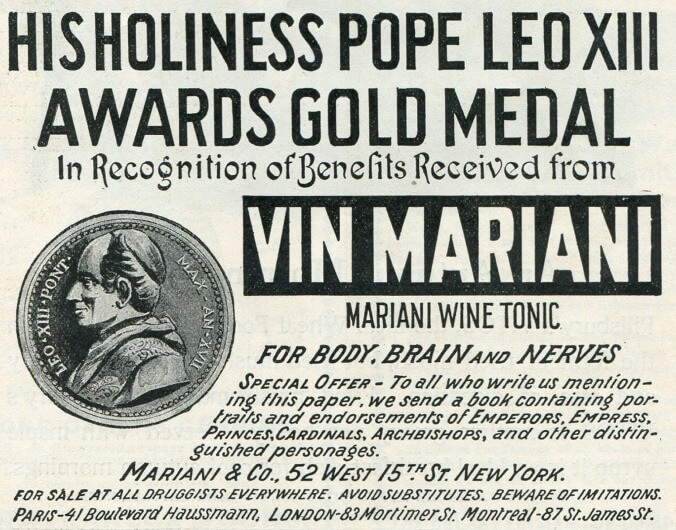Thing we were happiest to learn: Vin Mariani led to a far more innocuous and moderately less unhealthy beverage. In 1885, Dr. John S. Pemberton came up with his own beverage to rival Mariani, Pemberton’s French Wine Coca. (Neither Pemberton nor his wine were French. He was a Georgia-born Confederate Army veteran.) Like Mariani, Pemberton used coca leaves in his recipe, but he also added even more kick by adding caffeine from the kola nut. Pemberton marketed Wine Coca as a health tonic, claiming it eased everything from gastric distress to impotence to morphine addiction, which Pemberton himself suffered from, having been wounded in the Civil War.
In 1886, both Atlanta and Fulton County passed local prohibition ordinances, so Pemberton quickly came out with a non-alcoholic (but still full of cocaine!) version of his tonic, which he called Coca-Cola, marketing it as “the temperance drink.” Of course, the temperance drink still had cocaine in it, and would until 1904, when Coke switched to “a cocaine-free coca leaf extract,” which it uses to this day. A New Jersey company has a special federal exemption to extract cocaine from the leaves, and the cocaine is then purified for “medicinal use” by another company, in case anyone was looking for an idea for a heist movie. Coke uses a (cocaine-free) leftover material from that process as an ingredient.
Thing we were unhappiest to learn: Everybody was drunk and high on coke back in the day. Vin Mariani adherents included Ulysses S. Grant (who was drunk for most of his life, but was also coke-drunk when he wrote his presidential memoirs), inventor Thomas Edison (who “claimed it helped him stay awake longer”), French prime minister Jules Méline (who didn’t drink, but made an exception if the wine had cocaine in it), actress and singer Lillian Russell, writer Émile Zola, writer and politician Henri Rochefort, and a parade of other artists on both sides of the Atlantic.
Best link to elsewhere on Wikipedia: Non-alcoholic drink has some surprising info, like that “some fresh orange juices are above the UK ‘alcohol free’ limit of 0.05% ABV, as are some yogurts and rye bread,” which leaves us wondering how much rye bread you have to eat to get drunk. “Alcohol-free” also means different things to different countries. In Finland, anything 2.8% alcohol by volume or under is considered non-alcoholic, and Denmark raised its threshold from 0.1% to 0.5% “due to the better taste of 0.5%.” The U.S. and U.K. thresholds are also 0.5%, and in Japan it’s 1%. To put that in perspective, most light beers are between 4% and 4.25%.
Further down the Wormhole: Even without the cocaine, wine plays an important part in Catholicism, as it’s a key component in the eucharist, a ritual in which sacramental bread and wine represent the body and blood of Jesus (or if you’re a true believer, actually transform into the literal body and blood of Jesus H. Christ). And while observant Catholics tend to take their faith’s rituals very seriously, there was a time in medieval Europe that featured “light-hearted parodies of [Catholic mass] for certain Church festivities.” Good-natured as these parodies may have been, they’re seen as a precursor to the Black Mass, a satanic ritual which is in some sense a less light-hearted parody of mass. One of those light-hearted parodies that seems to have become a more serious religious observance is the Feast of the Ass, which we assure you isn’t as dirty as it sounds. The Feast of the Ass is celebrated on January 14, and we’ll discuss it next week.

